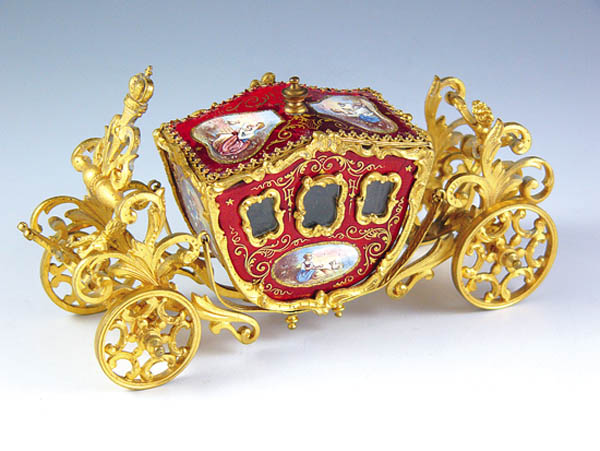Tales Of Old Vienna: Entrancing Austrian Enamels
Smack Dab In The Middle: Design Trends Of The Mid-20th Century
Really small packages.
During the 1800s, the master artisans of Vienna, Austria, re-created life in miniature. Must-haves of elegant living, from clocks to chairs to carriages, were re-imagined as elaborately decorated miniatures. Their enameled panels, with tiny, finely detailed renditions of classic scenes, were affixed to frameworks of gold, silver, copper, bronze, and other precious metals. Sought-after from the start, Viennese enamels continue to dazzle today's collectors.
Although perpetually fresh in its use of vivid coloration, enameling is actually an ancient art, dating back at least 3,000 years, to classic Greece. The enameling process, however, remains one that the Greeks would find familiar: enamel (essentially glass tinted with metallic pigments) is fired and fused to metal.
Vienna's claim to fame as "the enameling center of Europe" had very prosaic beginnings-in repair work. During the 19th century, decorative items from the Renaissance era were suffering the ravages of age. Damaged originals were brought to Viennese craftsmen for restoration. So skillful and undetectable were the repairs that the next step was a simple one: turning out newly-minted, less expensive reproductions. While most were clearly marketed as such, there was always an opening for sleight-of-hand. Antiques dealer Salomon Weininger, for instance, was convicted of keeping original pieces entrusted to him for repair, replacing them with quite well-made forgeries.
Merely mirroring what had come before soon lost its appeal for Vienna's creative talents. Artisans began to make selective use of Renaissance enameling techniques and themes, refining and adapting them in new ways suited to the times. These works offered homage to the past, rather than simply parroting it, and the move to originality paid off in droves. Viennese enamels attracted recognition at international exhibitions. Buyers appreciated the visual appeal of the varied structural elements utilized in the enameled creations, as well as the permanence of the glazes, which kept colors fresh and unfaded.
While copying the Renaissance in overall style, pictorial representations on Viennese enameled panels were very much of the 19th century. Pastoral vistas abounded, with lush greenery, bountiful floral groupings, peacefully burbling streams, and sun-kissed clouds. At the center of things were the leading players: statuesque maidens and their dashing suitors. Attendant nymphs watched on approvingly, and even the occasional cupid took wing. What stories did these scenes tell? Their legends had long since vanished from popular memory. All that really mattered was the of-the-moment beauty of the illustration.
Viennese enamels proved ideal accents for the 19th century drawing room. Their subtle shadings, with occasional eye-popping bursts of brilliant color, provided the perfect complement to similarly-hued furnishings and wall hangings. The enameling technique was initially applied to usable objects, such as bowls, trays, and vases, of normal, or even enhanced size. But the artisans of Vienna came to realize that "anyone can do large." Their enameled pieces became smaller and smaller, as did any realistic functions the objects might once have served. Exquisite, and impossibly tiny, scent and snuff bottles were now gazed at admiringly, rather than actually put to their intended use. Miniature jewel chests were equipped with artfully designed pullout drawers, just the right size to hold, well, nothing, really. The focus had shifted to the purely ornamental.
The most fascinating miniatures are the "novelties," which work their intricately detailed magic within just a few inches. Even Tom Thumb would find himself hard-pressed to squeeze into a 3-by-6-inch Viennese coach. These were conveyances meant for really small fry.
Viennese enamel miniatures are, in effect, the tiniest of theatrical props, waiting to make their appearance on some elfin stage. Supreme art and artifice have gone into their creation. Collectors value Viennese enamels not only for what they are: sumptuously realized objets d'art, but also for what they represent, artwork which celebrates the past by melding it with the future. That's a worthy goal for art in any age.
Photo associate: Hank Kuhlmann
Donald-Brian Johnson is the co-author of numerous books on design and collectibles, including "Postwar Pop," a collection of his columns, and the upcoming "Lost in the '50s." Please address inquiries to: donaldbrian@msn.com.

Donald-Brian Johnson
Donald-Brian Johnson is a nationwide columnist, and the co-author of numerous Schiffer books on design and collectibles. His most recent, "Postwar Pop," is a collection of his columns.














